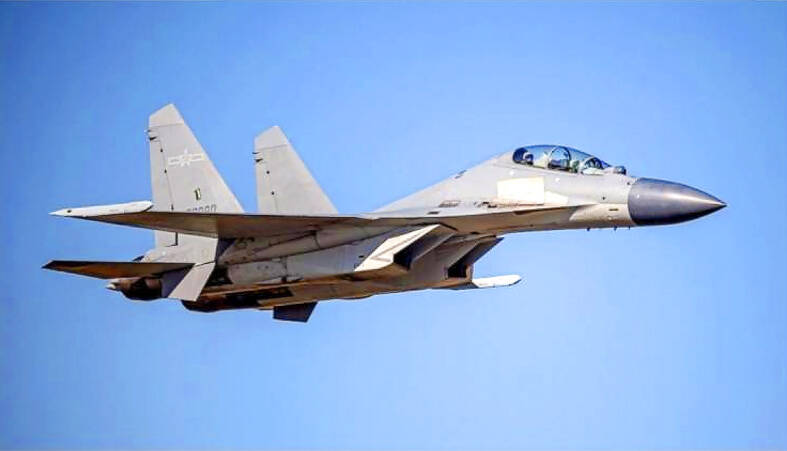A total of 71 Chinese military aircraft and seven naval vessels were detected around Taiwan from 6am on Sunday to 6am yesterday, the Ministry of National Defense said.
It was the most Chinese military craft detected within a 24-hour period so far this year.
Forty-seven aircraft were spotted either crossing the median line of the Taiwan Strait or entering Taiwan’s southwestern air defense identification zone (ADIZ), the ministry said.

A Chinese J-16 fighter flies in an undisclosed location in an undated photograph provided by the Ministry of National Defense.
Photo: AP
The armed forces monitored the situation, and tasked combat air patrol aircraft, navy vessels and land-based missile systems to respond to the Chinese activities.
The Chinese planes included 12 Shenyang J-11 and six Sukhoi Su-30 fighter jets, one CASC Rainbow CH-4 uncrewed aerial vehicle, six Chengdu J-10 and 18 J-16 fighter jets, one Shaanxi Y-8 EW, one Y-8 ASW, and one KJ-500 airborne early warning and control plane, as well as one Guizhou WZ-7 Soaring Dragon drone, the ministry said.
The ministry on Sunday evening said the Chinese maneuvers amounted to intimidation and psychological warfare aimed at manipulating public opinion in Taiwan.
It said Taiwan-US cooperation is conducive to freedom, openness, and peace and stability in the Indo-Pacific region, and that the military would continue to improve its preparations based on enemy threats and self-defense needs.
Taiwan’s military is absolutely determined, capable and confident in defending the nation’s sovereignty and ensuring its security, it said.
Speaking at a legislative hearing yesterday, Mainland Affairs Council Minister Chiu Tai-san (邱太三) said he would issue a solemn protest over the incursions.
The ministry every day releases data on Chinese military incursions, not only regarding the nation’s ADIZ, but also crossings of the median line, Chiu said, adding that he is “of course very dissatisfied” with China’s actions.
The sorties by the Chinese People’s Liberation Army (PLA) came after US President Joe Biden on Friday signed into law the Fiscal 2023 National Defense Authorization Act, which includes provisions to authorize US$2 billion in loans to Taiwan to buy US-made weapons.
The act also includes a nonbinding provision that Taiwanese naval forces be included in the Rim of the Pacific military exercises to be carried out by the US military and its allies in the region in 2024.
However, the act does not require the US administration to invite Taiwan to join the drills.
Beijing has strongly objected to the act, seeing it as an attempt to change the “status quo” by challenging the “one China” policy and Sino-US joint agreements on how to handle the issue of Taiwan.
On Sunday, the PLA Eastern Theater Command held joint combat readiness patrols and “strike drills” in the sea and airspace around Taiwan.
“This is a resolute response to the current US-Taiwan provocation,” the command said.
Additional reporting by Chen Yu-fu
Source: Taipei Times - 2022/12/27




















